 TrophyCatch Season 5 has been rolling along smoothly. Florida's spawning season, January - March, produced some outstanding catches, including the current season leader (below). Catches have slowed as we enter the summer months, but even the "dog days" can be good days for catching a trophy in Florida, the “Bass Fishing Capital of the World”!
|
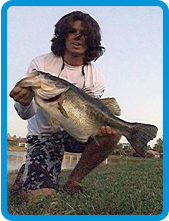 Angler Dominic Montalto has taken the Season 5 lead with his 16-pound 12-ounce largemouth bass caught in a private pond in Estero, Florida! This approaches the current certified state record of a 17-pound 4-ounce largemouth bass caught in Polk County in 1986. A team of FWC biologists verified the accuracy of Dominic’s scale, as well as his catch videos and photos. Dominic was fishing from shore around dusk with a Johnny Morris Titanium 8 Heavy-action rod with a Bass Pro Shops Pro Qualifier 7.1-1 reel, using a XPS Z9R Perch Swimbait lure in bluegill color. This is also the largest bass submitted to TrophyCatch since the program's inception in 2012.
|
TrophyCatch has announced a new partnership with Shimano
and new monthly "Lunker Leader" prizing for the angler with the
heaviest Lunker Club total each month. Each month offers a different prize from Shimano’s vast array of fishing products.
Shimano is also providing the following Seasonal Big Bag prizing to the top 3 qualifying anglers with the heaviest season bag weights:
- 1st Prize: 3 GLoomis & Metanium combos
- 2nd Prize: 3 EXPRIDE & Chronarch MGL combos
- 3rd Prize: 3 Exage & Casitas combos
The FWC “stocked” tagged trophy bass into the Bass Pro Shops Orlando Super Aquarium this past quarter to kick off Gone Fishing, a national Bass Pro Shops program to promote fishing. The bass stocking also highlighted FWC’s Trophy Bass Tagging Study,
which works hand-in-hand with TrophyCatch to promote Florida bass
fishing and collect important bass data from anglers. Boy Scouts of
America Ocoee Pack 217 received a donation of rods and reels from
Bass Pro Shops as part of the event.
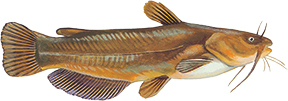 Size: The state record is 5.05 pounds, but most catches will average closer to half a pound. The Big Catch minimum qualifying sizes are 1.5 pounds or 14 inches for adults, and 1.0 lbs or 10 inches for youth (BigCatchFlorida.com).
Identification and similar species: This species is brownish above, and white to yellow below. The dorsal
and pectoral fin spines and barbells make this fish easy to diagnose as a
catfish. The tail is usually squared, but may be slightly forked. This fish is often called a “buttercat” due its coloration—though the name can be a cooking suggestion as well! The related but darker brown
bullhead also occurs in Florida and is usually much darker, sometimes with distinct black-and-white mottling. The surest way to tell these
two apart is to examine the chin (not mouth) barbells: those of the
yellow bullhead will be entirely white or yellow, while those of the
brown bullhead will range from darkly spotted to entirely black.
Angling qualities: Summer is a great time to sit back, soak a line, and do some catfishing! The yellow bullhead is a small catfish, but an important component of the catfish angler’s catch in some parts of Florida. Due to its diminutive size, light tackle is recommended. All popular catfish baits will attract this species, with favorites including various commercial catfish preparations, chicken livers, and red wigglers. The yellow bullhead’s preference for the latter often causes it to end up on the lines of bottom-fishing bream anglers. Handle bullheads with care to avoid a painful puncture from the dorsal or pectoral fin spines! This fish, like most other catfishes, can provide excellent table fare..
Where to catch them: While there aren't any locales particularly noted for yellow bullhead fishing, these small catfish occur in most Florida waters, from rivers and canals to lakes and ponds. Fishing bait on the bottom almost anywhere in the state might put a "buttercat" on the end of your line!
Illustration by Duane Raver, Jr.
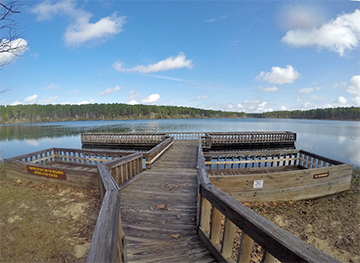 Size: 318 acres (Hurricane Lake) and 106 acres (Bear Lake).
Location: Okaloosa County (Hurricane Lake) and Santa Rosa County (Bear Lake). Both lakes are located in the Blackwater State Forest.
Description: Hurricane Lake and Bear Lake (in photo to left) are two of six Commission Managed Impoundments in the Florida Panhandle, created by the FWC starting in the 1950s. Located about 10 miles apart in the Blackwater State Forest, these impoundments were constructed to provide unique freshwater fishing opportunities to the area. Both lakes provide largemouth bass, bluegill sunfish, redear sunfish, and channel catfish while Bear Lake also contains black crappie and sunshine bass.
During the summer months largemouth bass can be targeted in deeper water around structure. Fish the edges of brush piles or flooded timber with crankbaits or spinnerbaits. A slow retrieve can often make the difference when fish are sluggish from warm water temperatures. Bluegill and redear sunfish will congregate on gravel beds in both lakes and can be caught by fishing on the bottom with live crickets or wigglers. Use small hooks, light line, and fasten a split-shot sinker several feet above the hook. These beds are easily identified as large light colored areas on the bottom and can be accessed from the bank around any of the campgrounds. For channel catfish, fish on the bottom in deeper water with chicken livers or night crawlers. The best time to target these fish is during the evening around sunset or at night.
|
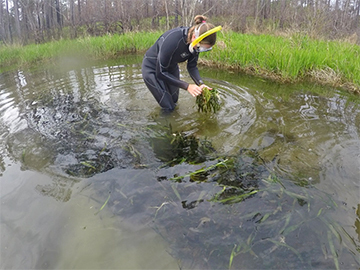 Good shoreline access with
fishing fingers and fishing piers are available on both lakes along with
concrete boat ramps and ample parking. Both lakes are trolling motor
only and follow the regulations detailed for other Fish Management Areas
(FMA). In addition to the unique fishing opportunities, the Florida
Forest Service maintains campgrounds at both lakes which provide a
variety of outdoor activities including hiking, wildlife viewing, and
kayaking.
Over the
years, natural succession of these aging reservoirs has progressively
degraded the in-lake habitat, ultimately affecting sport fish
populations. In response, the FWC is taking action to improve this
habitat and establish a healthy forage base for these popular sport
fish. Last fall, Hurricane Lake received 4 large brush pile fish
attractors composed of bald cypress. This year the FWC plans to add to
these fish attractors with more hardwood species. Three experimental
plots of eelgrass were transplanted this spring in an effort to
establish a beneficial, native plant (eelgrass transplanting shown in photo above). Future projects on Hurricane Lake
include the installation of gravel beds alongside artificial Mossback
fish attractors to provide spawning habitat and aid in the propagation
of sport fish species. Bear Lake is scheduled to receive hardwood brush
pile attractors, while both lakes will receive the stocking of forage
species such as threadfin shad.
These
in-lake enhancements should improve sport fish populations for
freshwater anglers while the beautiful panhandle scenery provides an
aesthetic unmatched throughout the state.
|
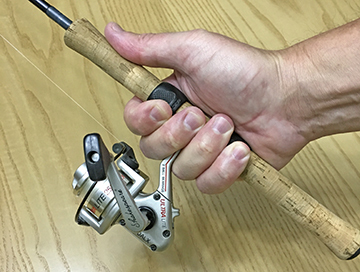 WHAT is “light tackle”? Simply put, it’s the smallest
practical gear—line, rod, and reel—for the angling situation at hand.
But light tackle is a relative term. What might be called light for a
bluegill is a different thing than light tackle for a six-pound
largemouth bass. And light tackle for landing that bass in open water is
a different thing than light tackle for extracting that same bass from a
hydrilla-laden canal or flooded timber. However, most anglers would
probably agree (within a pound or two) with the following light-line
recommendations for the following species.
-
Largemouth bass: 4 to 8 pound test line in open waters; up to 10-12 pound test in heavily obstructed waters.
-
Butterfly peacock: 4 to 6 pound test.
-
Bluegill and other sunfish, Mayan cichlid, and spotted tilapia: 2 to 4 pound test.
-
Black crappie, Oscar, and blue tilapia: 4 to 6 pound test.
|
WHY
use light tackle? First and foremost, many anglers relish the added
challenge. Skillfully landing a one-pound bluegill on wispy 2-pound
monofilament and a limber ultralight spinning outfit elevates the
encounter to an epic one-on-one battle. Another reason to try light
tackle is the fact that many waters receive heavy pressure. Fish in such
locales become wary and more reluctant to strike, and a finer, less
visible line may be the difference between an empty livewell and a full
one. Additionally, smaller-diameter lines create less guide friction and
wind resistance, allowing longer and more accurate casts. Finally,
becoming proficient with light tackle can pay big dividends in increased
skills. Light-tackle techniques apply to any category of fishing, and
when a truly large fish strikes, the experienced light tackle angler is
all the more ready for the situation.
WHEN
is light tackle too light? This will be a decision based on an angler’s
individual skill and experience, but the focus rests primarily on the
quarry—the fish itself. If a fish that will be released is played to
exhaustion and reaches the point where it will not recover, the tackle
is too light. If the angler repeatedly breaks off fish that will spend
the next week or two sporting unwanted hardware in their dental gear,
the tackle is too light.
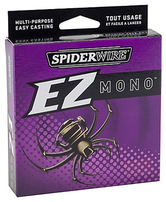 HOW do I get started in light tackle fishing?
Line:
The fishing line is the very heart of a light-tackle system. In fact,
when many anglers talk about light tackle, they are referring
specifically to the pound-test of the line being used. Always purchase
premium lines. Top quality lines will usually be a smaller diameter for a
given pound test, thus maximizing the light-tackle advantages of
reduced visibility to fish and better casting distance and accuracy.
Knots become much more critical when using light line—a poor tie can cut
a line’s strength in half! Note that modern braided lines with their
high strength and small line diameter have added a new dimension to
light tackle. For those just getting started in light tackle fishing, a
fine but strong braided line can give you that “light tackle” feel but
still provide a wide safety margin until you build up some skills.
|
 Reel: After a premium line, a high-quality reel is
probably next in importance. Light tackle fishing means that the line
will be pushed to the breaking point much more often, and quality reel
components and a silky-smooth drag are essential. And when it comes to
ball bearings, more is better! This is also one place where I recommend
slightly bending the “smallest practical gear” part of the light-tackle
definition. While many of the palm-sized fishing reels available today
are technological masterpieces that can be a delight to use, some of
these ultra-small reels have such tiny diameter spools that they
sacrifice line capacity and inhibit casting distance. When choosing a
reel, select one that lists the line you are planning to use most often
as the smallest recommended line. For example, if you plan to drop to 4
pound test line for some of your open-water bass fishing, buy a reel
that is designed for use with 4, 6, and 8-pound lines, not one that is
designed for 1, 2, and 4-pound lines. Why? The larger diameter spool on
the first reel will not only allow the line to leave the real more
easily via larger coils, but will also hold more line if an unexpectedly
large fish makes a sustained run.
|
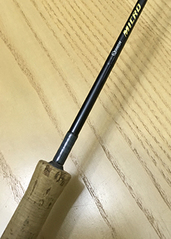 Rod: Don’t confuse light tackle with the Ultralight,
Light, and Medium designations that rod manufactures use to label the
action of their rods. Instead, make your purchase based on the
recommended lines listed on the rod blank. As with the reel, choose a
rod that lists your most-used line near the low end of the range—for
example, select a rod that will handle 4-10 pound line if you are
planning to fish with 4-pound line most often. Not only will the
resultingly stiffer rod aid in hook-setting, but it will also be easier
to find a longer rod. Lengthier rods result in longer casts, and also
provide more control over a fish being finessed toward the landing net.
High quality rod guides are also particularly important in light-tackle
angling.
|
 Lures:
Thankfully, the high popularity of light-tackle angling has resulted in
the availability of a wide selection of light and ultralight lures. Most
will be tinier versions of already-popular offerings, and can be a
great deal of fun to use. While bass anglers should have no trouble
finding lures suitably “light” for their quarry, the panfish angler may
have to hunt a little to locate the tiniest jigs, spoons, spinners, and
crankbaits. Since finer lines and more limber rods make hooksetting more
difficult, anglers should take special care to sharpen hooks before
using them. Rapala provides some excellent ultralight minnows and crankbaits. The Rebel Teeny Wee Crawfish, Mepps and Rooster Tail spinners, and Dardevle spoons are other longtime favorites.
Playing and landing fish:
Light-gear aficionados should set the reel drag between one-third and
one-half the weight of the line they are using (at about 2-3 pounds pull when using 6-pound line, for example), and
learn to apply additional pressure when needed by palming the spool
rim. Don’t try to arrest the strong run of a large fish; rather, wait
until it stops, and then reel in while “pumping” the fish using the rod.
When a fish jumps, drop the rod tip to create slack and avoid breaking
the line. If a fish makes it into heavy structure, sometimes slackening
the line for a moment will coax it back out. In the end, however,
experience and practice are the best teachers, and they will make the
light tackle angler a better angler in any situation!
|
You may be pretty familiar with anything that might bite on the end of your line, but do you know your minnows? Shown below are some of the species you’re most likely to come across in Florida, either via cast net or dip net. How many have you seen? (Note: Drawings are not to scale; check text for actual sizes.)
 Mosquitofish (2 ½”) — Probably the most common freshwater fish in Florida, this rather plain fish can be identified by the one or two broken,
vertical stripes on its tail. Female is easily told by the distinct black spot
on the belly. Melanistic (dark-pigmented) forms may have black spots sprinkled
over the body or even appear entirely black. Derives its name from its
preferred food of mosquito larvae. A fair bait for bluegill and small bass.
|
 Bluefin killifish (2”) — This common minnow is easily
told by the brown back and the bold, black stripe down the side which ends in a
black spot. The blue fins referred to in the name are visible only on the male
during the breeding season. A fair bait for bluegill and the occasional small
bass. Do not confuse with largemouth bass fry which also possess a dark line
along the body but have a divided dorsal fin; bass fry must be released
immediately if netted.
|
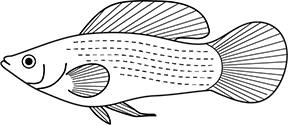 Sailfin molly (5”) — The male of this aptly-named species
is easily recognized by the very large, elongated dorsal fin which may be edged
in orange; the male’s tail may also be bright orange and blue. However, both
sexes can be identified by the five to eight finely dotted lines along the
body. Mollies are noticeably larger and less slender than most of our other
common minnows. They provide a good bait for bluegill and crappie, with larger
individuals useful for tempting bass.
|
 Seminole killifish (6 ½”) — A large minnow compared with
most of the others shown here, this one is occasionally caught on hook-and-line
on such baits as small doughballs, live worms, small jigs or flies. It is very
nondescript, but can be told by its bigger size, light greenish color, and rows
of fine spots (and faint vertical bars in the case of the female) along the
side. It is often seen over open, sandy bottoms near vegetation. Reportedly a
fair bait for bass.
|
 Brook silverside (5”) — This elongate and streamlined
fish has a beak-like snout and a very distinct silver stripe along its side. Differs
from most of these other minnows (except for shad) in that it roams in open
water rather than associating with shoreline vegetation. A schooling minnow
that can be abundant.
|
Has the habit of swimming just under the surface and
occasionally skipping along the top of the water, especially when chased. Not
very hardy and therefore a poor bait.
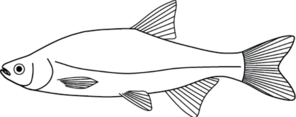 Golden shiner (12”) — The golden shiner is a deep-bodied
and extremely compressed (flat) fish; also note the strongly down-curved
lateral line. A scaleless keel (ridge) is present on the bottom of the belly.
The golden color for which the fish is named can be helpful in identification,
but is not always present. This species is well-known to most anglers and is the best all-around bait for largemouth bass
and peacock bass. Shiners can be cast-netted or caught on hook-and-line using
tiny (size 10-12) hooks and doughballs.
|
 Threadfin shad (To 9” though rarely exceeds 6”) — An
extremely compressed (flat) fish with a distinct dark shoulder spot, long
dorsal fin ray, and pointed snout. The body is bright silver, with a dark back.
The scales are large in relation to the size of the fish and easily rub off. The
threadfin can be told from the gizzard shad because it possesses black specks
on the chin and floor of the mouth and yellow fins. A less scientific but
nevertheless helpful test is to “scratch” the nose of the shad with a
fingernail; if the nail catches and pulls open the bottom jaw it is likely a
threadfin. (The threadfin’s lower jaw extends out farther then the gizzard
shad’s.) Although the threadfin shad is an excellent forage and bait for
largemouth and sunshine bass, the gizzard shad (below) can quickly grow too large to be
preyed upon and can rapidly overpopulate a lake. Anglers should therefore not
transplant any shad to other waters.
|
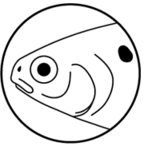 Gizzard shad (To 20” though rarely exceeds 12”) — Note
the lower jaw which does not extend past the snout (as well as the other
features mentioned above) to distinguish this from the threadfin shad. It is
also fairly safe to assume that any shad bigger than 6” is a gizzard shad. Small
gizzard shad can provide good bass bait, but this species quickly grows too
large for even the biggest bass and if it overpopulates can become a serious
lake management problem. Again, never transplant any species of shad to other
waters.
|
To contact the Florida Freshwater Angler, email John Cimbaro.
|